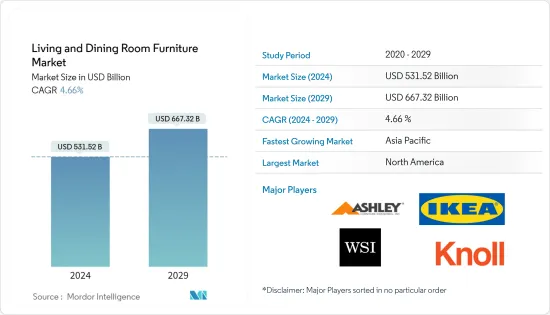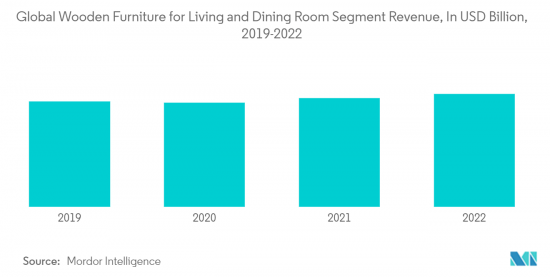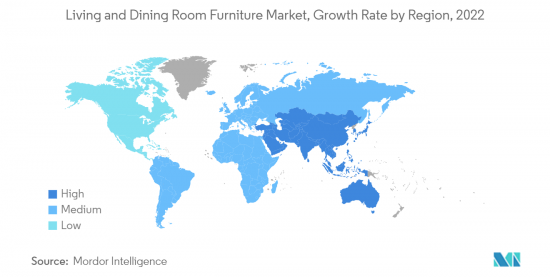 |
市場調査レポート
商品コード
1430582
リビング・ダイニングルーム用家具:市場シェア分析、産業動向、成長予測(2024~2029年)Living and Dining Room Furniture - Market Share Analysis, Industry Trends & Statistics, Growth Forecasts (2024 - 2029) |
||||||
● お客様のご希望に応じて、既存データの加工や未掲載情報(例:国別セグメント)の追加などの対応が可能です。 詳細はお問い合わせください。
| リビング・ダイニングルーム用家具:市場シェア分析、産業動向、成長予測(2024~2029年) |
|
出版日: 2024年02月15日
発行: Mordor Intelligence
ページ情報: 英文 148 Pages
納期: 2~3営業日
|
- 全表示
- 概要
- 目次
リビング・ダイニングルーム用家具市場規模は2024年に5,315億2,000万米ドルと推定・予測され、2029年には6,673億2,000万米ドルに達し、推定・予測期間(2024-2029年)のCAGRは4.66%で成長すると予測されます。

リビング・ダイニングルーム用家具市場は、世界の家具産業の重要なセグメントです。リビング・ダイニングルームで使用されるソファ、椅子、テーブル、キャビネット、その他の家具など幅広い製品が含まれます。快適でスタイリッシュな家具への需要の高まり、可処分所得の増加、ホームデコレーションやインテリアデザインへの注目の高まりなど、さまざまな要因が市場を牽引しています。最近では、狭い居住空間でも多目的に使える多機能家具が動向となっています。ソファベッド、収納オットマン、伸長式ダイニングテーブルなど、革新的な製品の開発につながった。さらに、オンライン・ショッピングの普及により、消費者は自宅にいながらにして家具を閲覧・購入できるようになりました。
地理的には、アジア太平洋地域がリビング・ダイニングルーム用家具の市場として最も急成長すると予想され、その原動力となっているのは、都市化の進展、可処分所得の増加、中国やインドなどの国々におけるライフスタイルの変化です。北米と欧州も、高い生活水準とスタイリッシュで快適な家具への需要の高まりによって、リビング・ダイニングルーム用家具の重要な市場となっています。
COVID-19の流行はリビング・ダイニングルーム用家具市場にプラスとマイナスの影響を与えました。一方では、パンデミックは、人々が家で過ごす時間を増やし、快適で機能的な生活空間を作ることを優先させたため、家庭用家具の需要を増加させました。その結果、一部の家具小売業者やメーカーは売上を急増させました。その一方で、パンデミックは世界のサプライチェーンや製造業務に混乱をもたらし、家具製品の不足や生産・納入の遅れにつながった。その結果、特定の品目の入手が困難になり、場合によっては価格の上昇を招いた。さらに、パンデミックによる景気の不透明感から、一部の消費者は家具を含む非必需品への支出を延期または削減しました。
リビング・ダイニングルーム用家具の市場動向
木製のリビング・ダイニングルーム用家具セグメント
木製家具市場は、リビング・ダイニングルーム用の木製家具に焦点を当てています。バーテーブル、コーヒーテーブル、オケージョナルサイドテーブル、ダイニングテーブル、ビュッフェテーブル、テレビ台、メディア台、本棚、ワインキャビネット、チェストなどのリビング・ダイニングルーム用収納家具が含まれます。今年の売上では米国が大きなシェアを占めています。
リビング・ダイニングルーム用の木製家具は、長年消費者の間で人気があります。木製家具が市場を牽引している理由はいくつかあります。リビング・ダイニングルーム用木製家具の美的魅力、耐久性、多用途性、持続可能性、健康上の利点といった要素が市場を牽引し、消費者の間で人気のある選択肢となっています。

アジア太平洋地域が最も高い成長を遂げると予想される
成長著しい不動産、住宅建設の増加、新興国市場における個人の可処分所得の増加といった要因が、予測期間中にアジア太平洋地域のリビングルーム用家具市場を押し上げると予想されます。さらに、特に中国とインドにおける熟練労働者の不足、より良い輸送施設の必要性、不十分なインフラ設備が市場成長の妨げになると思われます。
住宅戸数の増加、中間層人口の増加、家計支出の増加、ライフスタイルの変化、ブランド家具への嗜好の高まりは、予測期間中に同地域の市場需要を増加させる主な要因の一部です。

リビングダイニング家具産業の概要
本レポートでは、世界の主要なリビング・ダイニングルーム用家具市場プレイヤーを取り上げています。市場シェアの面では、現在、少数の大手企業が市場を独占しています。しかし、需要は消費者の所得によって左右されます。大企業は大量仕入れ、幅広い製品、効果的なマーチャンダイジングとマーケティングで競争しています。小規模企業は、市場セグメントに焦点を絞り、製品の充実度と優れた顧客サービスによって競争しています。
その他の特典:
- エクセル形式の市場予測(ME)シート
- 3ヶ月間のアナリスト・サポート
目次
第1章 イントロダクション
- 調査の前提条件と市場定義
- 調査範囲
第2章 調査手法
第3章 エグゼクティブサマリー
第4章 市場力学
- 市場概要
- 市場促進要因
- 市場抑制要因
- バリューチェーン/サプライチェーン分析
- ポーターのファイブフォース分析
- 供給企業の交渉力
- 買い手/消費者の交渉力
- 新規参入業者の脅威
- 代替品の脅威
- 競争企業間の敵対関係の強さ
- リビング・ダイニングルーム用家具市場に影響を与える動向についての洞察
- 市場における技術革新に関する洞察
- COVID-19が市場に与える影響
第5章 市場セグメンテーション
- タイプ別
- シートとソファ
- 椅子とテーブル
- その他
- エンドユーザー別
- 家庭用
- 業務用
- 流通チャネル別
- 百貨店
- 個人家具小売店
- 工場アウトレット
- オンライン
- その他
- 地域
- 北米
- 南米
- アジア太平洋
- 中東・アフリカ
- 欧州
第6章 競合情勢
- 市場集中度の概要
- 企業プロファイル
- Ashley Furniture
- IKEA
- Williams-Sonoma
- Knoll Inc.
- Masco Corp
- Sears Holdings Corp
- KOKUYO Furniture Co. Ltd
- Herman Miller Inc.
- Bernhardt Furniture Company
- Vogue Furniture 4U*
第7章 市場機会と今後の動向
第8章 免責事項
The Living and Dining Room Furniture Market size is estimated at USD 531.52 billion in 2024, and is expected to reach USD 667.32 billion by 2029, growing at a CAGR of 4.66% during the forecast period (2024-2029).

The living and dining room furniture market is a significant segment of the global furniture industry. It includes a wide range of products such as sofas, chairs, tables, cabinets, and other furniture items used in living and dining rooms. Various factors drive the market, such as the growing demand for comfortable and stylish furniture, the rising disposable income, and the increasing focus on home decor and interior design. Recently, there is a trend toward multifunctional furniture that can serve multiple purposes in smaller living spaces. It led to the development of innovative products such as sofa beds, storage ottomans, and extendable dining tables. Additionally, the popularity of online shopping made it easier for consumers to browse and purchase furniture items from the comfort of their homes.
Geographically, the Asia-Pacific region is expected to be the fastest-growing market for living and dining room furniture, driven by rising urbanization, increasing disposable income, and changing lifestyle patterns in countries such as China and India. North America and Europe are also significant markets for living and dining room furniture, driven by the high standard of living and the growing demand for stylish and comfortable furniture items.
The COVID-19 pandemic positively and negatively affected the living and dining room furniture market. On the one hand, the pandemic increased demand for home furnishings, as people spend more time at home and prioritize creating comfortable and functional living spaces. It resulted in a surge in sales for some furniture retailers and manufacturers. On the other hand, the pandemic also caused disruptions to global supply chains and manufacturing operations, leading to shortages and delays in the production and delivery of furniture products. It impacted the availability of certain items and caused price increases in some cases. Additionally, the economic uncertainty caused by the pandemic led some consumers to postpone or reduce their spending on non-essential items, including furniture.
Living And Dining Room Furniture Market Trends
Wooden Furniture for Living and Dining Room Segment
The Wooden Furniture market segment focuses on wood-made furniture in living and dining rooms. It includes bar, coffee, occasional side tables, dining and buffet tables, TV and media stands, bookshelves, wine and other cabinets, chests, and other living and dining room storage furniture. The United States accounted for the major market share in revenue this year.
Wooden furniture for the living and dining room segment is popular among consumers for many years. There are several reasons why wooden furniture is driving the market. The aesthetic appeal, durability, versatility, sustainability, and health benefits factors of wooden furniture for the living and dining room segment are driving the market and making it a popular choice among consumers.

Asia-Pacific is Anticipated to Witness the Highest Growth
Factors like escalating real estate growth, increasing residential construction, and growing personal disposable income in developing countries, are anticipated to boost the living room furniture market in Asia-Pacific over the forecast period. Moreover, the shortage of skilled labor, especially in China and India, the need for better transport facilities, and insufficient infrastructural facilities will likely hamper the market growth.
Growth in housing units, increasing middle-class population, rise in household expenditure, change in lifestyle, and the increased preference for branded furniture, are some of the major factors that will increase the demand for the market in the region during the forecast period.

Living And Dining Room Furniture Industry Overview
The report covers major international living and dining room furniture market players. In terms of market share, few of the major players currently dominate the market. However, demand is driven by consumer income. Large companies compete through volume purchasing, breadth of products, and effective merchandising and marketing. Small companies focus on a market segment and compete through the depth of products and superior customer service.
Additional Benefits:
- The market estimate (ME) sheet in Excel format
- 3 months of analyst support
TABLE OF CONTENTS
1 INTRODUCTION
- 1.1 Study Assumptions and Market Definition
- 1.2 Scope of the Study
2 RESEARCH METHODOLOGY
3 EXECUTIVE SUMMARY
4 MARKET DYNAMICS
- 4.1 Market Overview
- 4.2 Market Drivers
- 4.3 Market Restraints
- 4.4 Value Chain / Supply Chain Analysis
- 4.5 Porter's Five Forces Analysis
- 4.5.1 Bargaining Power of Suppliers
- 4.5.2 Bargaining Power of Buyers/Consumers
- 4.5.3 Threat of New Entrants
- 4.5.4 Threat of Substitute Products
- 4.5.5 Intensity of Competitive Rivalry
- 4.6 Insights on Trends Influencing the Living and Dining Room Furniture Market
- 4.7 Insights on Technological Innovations in the Market
- 4.8 Impact of COVID-19 on the Market
5 MARKET SEGMENTATION
- 5.1 By Type
- 5.1.1 Seats and Sofas
- 5.1.2 Chairs and Tables
- 5.1.3 Others
- 5.2 By End User
- 5.2.1 Household
- 5.2.2 Commercial
- 5.3 By Distribution Channel
- 5.3.1 Departmental Stores
- 5.3.2 Independent Furniture Retailers
- 5.3.3 Factory Outlets
- 5.3.4 Online
- 5.3.5 Others
- 5.4 Geography
- 5.4.1 North America
- 5.4.2 South America
- 5.4.3 Asia-Pacific
- 5.4.4 Middle East & Africa
- 5.4.5 Europe
6 COMPETITIVE LANDSCAPE
- 6.1 Market Concentration Overview
- 6.2 Company Profiles
- 6.2.1 Ashley Furniture
- 6.2.2 IKEA
- 6.2.3 Williams-Sonoma
- 6.2.4 Knoll Inc.
- 6.2.5 Masco Corp
- 6.2.6 Sears Holdings Corp
- 6.2.7 KOKUYO Furniture Co. Ltd
- 6.2.8 Herman Miller Inc.
- 6.2.9 Bernhardt Furniture Company
- 6.2.10 Vogue Furniture 4U*
